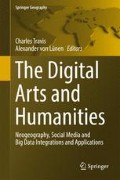Abstract
This article goes beyond considerations of digital media supporting identity and community to discuss the ways in which digital technology itself resembles and even parallels traditional indigenous means of producing and sharing knowledge and of experiencing time and space. Drawing from examples ranging from Aztec maps that represented time-space units simultaneously, through discussing indigenous codex and glyphs in which visual language is able to convey meaning using simultaneity rather than chronological narration, to the use of performance for durable cultural storage and transmission, this article points to the many areas of convergence between the multimodal communication that digital media increasingly enable and ancestral practices of indigenous peoples around the world.
Access this chapter
Tax calculation will be finalised at checkout
Purchases are for personal use only
Notes
- 1.
Comprising the Heiltsuk, Haida, Nuxalk, Tlingit, Makah, Tsimshian, Nuu-chah-nulth, Kwakwaka’wakw and Coast Salish cultures. It must be stressed that the use of potlatch varied widely among the different tribes.
- 2.
An app can be downloaded at http://www.codicemendoza.inah.gob.mx, accessed 8 November 2015.
- 3.
‘Expanded Expansions’ (1969) by Eva Hesse, is what the Guggenheim catalog describes as ‘a sculptural embodiment of opposites united. Both permanence and deterioration operate in the piece: fiberglass poles—rigid, durable entities—are juxtaposed with fragile, rubber-covered cheesecloth’ (Guggenheim 2015). Highly acclaimed in its hayday, today it is a rigid skin, wrinkled and decomposing in a wooden sarcophagus at the museum.
- 4.
A creature that can be considered Brazil’s Big Foot, extinct long ago but surviving on the oral accounts of Amazonian indigenous tribes. Paleontologists are allegedly beginning to accept other indigenous stories as valid sources of information on extinct species (Rinehart and Ippolito 2014, 168).
References
Ascher M, Ascher R (1997) Code of the Quipu: a study in media, mathematics, and culture. Dover, New York
Berger E (2012) The digital potlatch that needs defending. Swans http://www.swans.com/library/art18/berger04.html. Accessed 22 Feb 2015
Clarke AC (1973) Profiles of the future: an enquiry into the limits of the possible. Harper & Row, New York
Dyson L (2013) Indigenous peoples on the internet. In: Consalvo M, Ess C (eds) The handbook of internet studies. Wiley-Blackwell, Oxford, pp 251–269
Foster S (2014) Documentative: inclusivity and the ethics of interactive documentary in an indigenous and participatory context. In: Loft, Swanson (eds), pp 78–107
Goody J (1968) Literacy in traditional societies. Cambridge University Press, Cambridge
Grey C, Malins J (2004) Visualizing research: a guide to the research process in art and design. Ashgate, Aldershot
Grixti J (2011) Indigenous media values: cultural and ethical implications. In: Fortner RS, Fackler MP (eds) The handbok of global communication and media ethics. Wiley-Blackwell, Oxford, pp 342–364
Guggenheim (2015) Expanded expansions by Eva Hesse. http://www.guggenheim.org/new-york/collections/collection-online/artwork/1648. Accessed 27 May 2015
Haas A (2007) Wampum as hypertext: an American Indian intellectual tradition of multimedia theory and practice. Stud Am Indian Lit 4(19):78–80
Hill EB (1998) Pictorial documents and visual thinking in post-conquest Mexico. In: Hill EB, Cummins T (eds) Native traditions in the post-conquest world. Harvard University Press, Cambridge, pp 149–199
Hopkins C (2014) If history moves at the speed of its weapons .... In: Loft, Swanson (eds), pp 109–139
Innis H (1951) The bias of communication. University of Toronto Press, Toronto
Leon Portilla M (2003) Códices: los Antiguos Libros del Nuevo Mundo. Aguilar, México, D.F
Lewis JE (2014) A better dance and better prayers: systems, structures, and the future imaginary in aboriginal new media. In: Loft, Swanson (eds), pp 48–77
L’Hirondelle C (2014) Codetalkers recounting signals of survival. In: Loft, Swanson (eds), pp 140–168
Loft S, Swanson K (eds) (2014) Coded territories: tracing indigenous pathways in media art. Calgary University Press, Calgary
Massey D (2008) For space. SAGE, London
Mauss M (1950) The gift: the form and reason for exchange in archaic societies. Routledge, London
McLuhan M (1962) The Gutenberg Galaxy: the making of typographic man. University of Toronto Press, Toronto
O’Rourke K (2013) Walking and mapping: artists as cartographers. MIT Press, Cambridge
Pechawis A (2014) Indigenism: aboriginal world view as global protocol. In: Loft, Swanson (2014), pp 30–47
Rinehart R, Ippolito J (2014) Re-collection: art, new media, and social memory. MIT Press, Cambridge
Srinivasan R (2006) Indigenous, ethnic and cultural articulations of new media. Int J Cult Stud 9(4):497–518
Taylor D (2003) The archive and the repertoire: performing cultural memory in the Americas. Duke University Press, Durham
Urton G (2003) Signs of the Inka Khipu: binary coding in the andean knotted-string records. University of Texas Press, Austin
Van Leeuwen T (2011) The language of colour: an introduction. Routledge, London
Van Tijen T (1999) Nettime. http://www.nettime.org/Lists-Archives/nettime-1-9903/msg00005.html. Accessed 26 May 2015
Yamada Rice D (2012) Traditional theses and multimodal communciation. In: Andrews R, Borg E, Boyd-Davis S, Domingo M, England J (eds) The sage book of digital dissertations and thesis. SAGE, London, pp 157–176
Author information
Authors and Affiliations
Corresponding author
Editor information
Editors and Affiliations
Rights and permissions
Copyright information
© 2016 Springer International Publishing Switzerland
About this chapter
Cite this chapter
de la Garza, A. (2016). Aboriginal Digitalities: Indigenous Peoples and New Media. In: Travis, C., von Lünen, A. (eds) The Digital Arts and Humanities. Springer Geography. Springer, Cham. https://doi.org/10.1007/978-3-319-40953-5_3
Download citation
DOI: https://doi.org/10.1007/978-3-319-40953-5_3
Published:
Publisher Name: Springer, Cham
Print ISBN: 978-3-319-40951-1
Online ISBN: 978-3-319-40953-5
eBook Packages: Earth and Environmental ScienceEarth and Environmental Science (R0)

